Architectural coatings are an essential component of any metalwork project, as they provide protection against corrosion, weathering, and wear and tear. These coatings for curtain wall spraying are composed of several major constituents and systems, each of which plays a critical role in achieving optimal performance and longevity.
Constituents of Architectural Coating
One of the primary constituents of architectural coatings is the binder, which is responsible for holding the other components together and providing adhesion to the metal substrate. Binders can be classified into two main types: organic and inorganic. Organic binders are made from natural or synthetic polymers, such as acrylics, epoxies, and polyurethanes, while inorganic binders include silicates and phosphates.
Another critical component of architectural coatings for curtain wall repair is the pigment, which provides colour and opacity to the coating. Pigments can be organic or inorganic and are typically chosen based on their chemical stability, lightfastness, and hiding power. Inorganic pigments, such as iron oxide and titanium dioxide, are the most common choice for architectural coatings due to their excellent weatherability and resistance to fading.
The third major constituent of architectural coatings is the solvent, which is used to dissolve and disperse the binder and pigment particles. Solvents can be organic or inorganic and are typically chosen based on their evaporation rate, viscosity, and compatibility with the binder. Organic solvents, such as acetone and toluene, are commonly used in architectural coatings due to their high solvency power and fast drying times.
Different Coating Systems
In addition to these major constituents, architectural coatings also rely on several different systems to achieve their desired performance characteristics. These systems include primers, topcoats, and specialty coatings. Primers are used to provide adhesion and corrosion protection to the metal substrate, while topcoats are used to provide colour and gloss retention. Specialty coatings, such as high-temperature coatings and anti-graffiti coatings, are used to provide additional performance benefits in specific applications.
Overall, the major constituents and systems of architectural coatings for curtain wall refurbishment are carefully chosen and formulated to provide optimal protection, durability, and aesthetic appeal. By understanding these components, architects, engineers, and metalworkers can select the right coating system for their specific application and ensure long-lasting performance and protection.
For more information regarding architectural coating please read the infographic attached.




